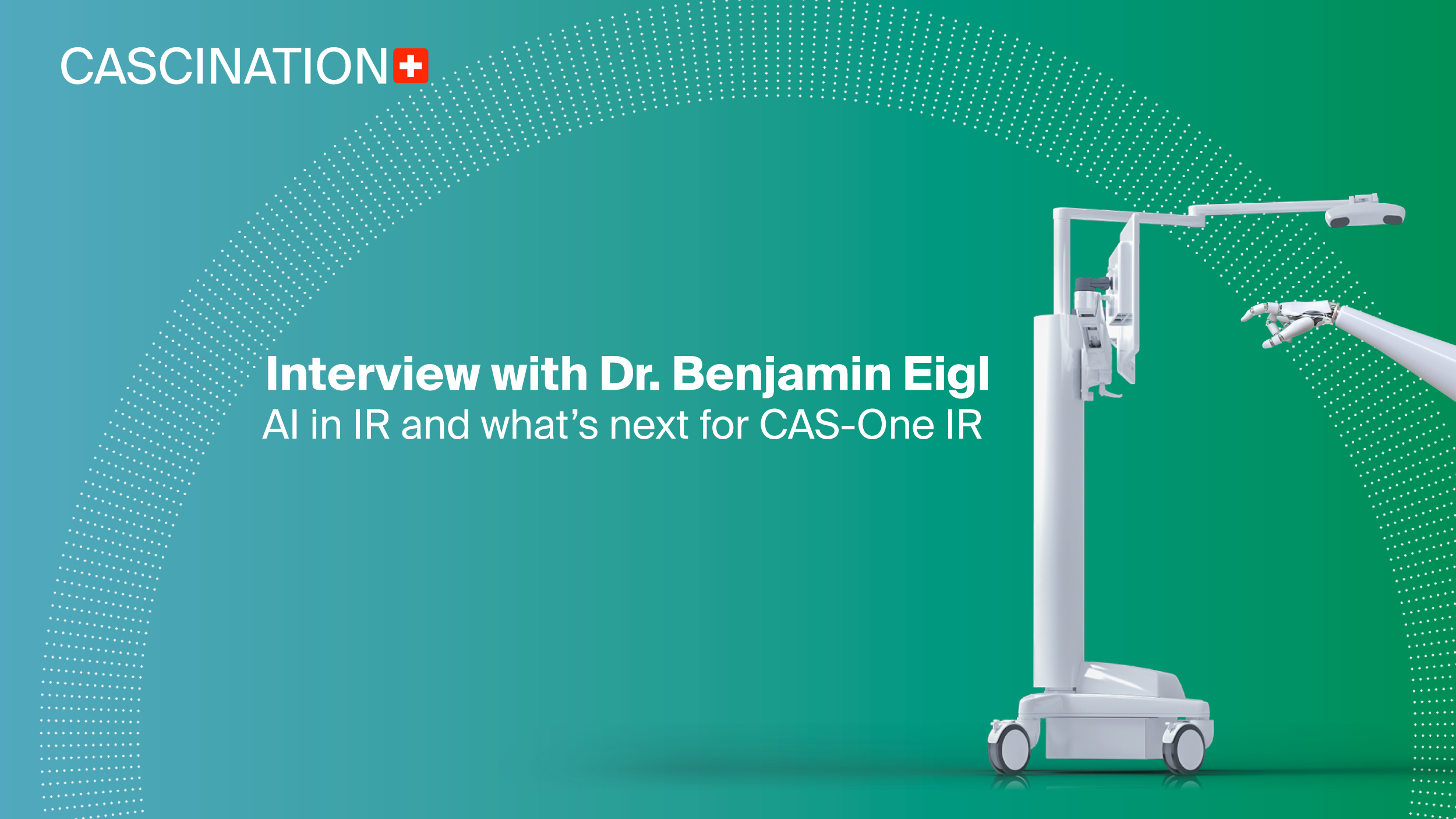Interview with Dr. Benjamin Eigl - AI in IR and what’s next for CAS-One IR
The newest CAS-One IR software, driven by Artificial Intelligence, is set to release soon (weeks!) – so we sat down with Dr. Benjamin Eigl for a quick interview to understand why this is so important.
Benjamin is one of the longest-tenured employees at CASCINATION. He has a wide range of experience in the company, from software programming and product development to clinical application and research collaboration.
What is considered AI anyways?
Benjamin Eigl: A recently proposed European law on Artificial Intelligence, called the AI Act, defines a range of techniques from "basic" statistical, through logic and knowledge-based, to complex machine learning approaches. While the former two include methods such as Bayesian estimation, inductive (logic) programming, or inference and deduction machines, the latter include supervised, unsupervised, and reinforcement learning techniques that use various methods, including Deep Learning.
This rapidly evolving family of "decision support systems" can bring multiple economic and societal benefits across social activities and industries. For example, modern healthcare and medicine have undergone an extraordinary evolution - from computer programs that support the analysis of medical images to their integration into almost all clinical and organizational practices. At the forefront of this change are radiology and various applications of surgery that use stereotactic or robotic guidance technologies.
How will AI be impactful in tumor ablation?
Benjamin Eigl: A significant challenge in medicine is the variance in outcomes, or noise. Be it the diagnostic variability in the histopathological assessment of pathologists, the variability in interpreting angiograms, or the disagreement between radiologists assessing the same images.
This inter-person variability, as does the intra-person variability, adds to the overall noise. Think of interventional radiologists performing repeat instrument placements in a phantom. While being experts in their field and the general conditions remain identical, you will observe some variability in placement performance.
First, there is a difference between IRs, which is mainly due to their skill set. But secondly, there is also a difference between the placements of a single person. Like the professional basketball player who never throws the ball twice in the same way (and thus occasionally misses), the IR will never place the instrument precisely the same way. While noise causes are multifaceted (e.g., skill difference, the pressure of the moment, general mood, time of the day, etc.), we must accept that it is present and to a high degree.
A specific example from a recent publication: up to 44% of ablation margins were misjudged - regardless of the radiologist's experience.1 Guidelines are essential to reduce noise in medicine, but other preventive measures are required. With the introduction of computer support in IO, variance has already been reduced, e.g., in treatment time, instrument placement performance, and inter-operator oncologic outcomes 2–4.
Arguably, an essential property of algorithms is their noise-free nature. Combined with the ability to handle increasingly complex problems, their use in interventional oncology to support decision-making will continue to grow.

Which features has CASCINATION focused on?
Benjamin Eigl: We notice an increase in "complex" cases performed in our Quality Ablation centers. These involve tumors in difficult-to-access locations, requiring multiple instruments' placement due to their size or proximity to critical structures. A good anatomical and spatial understanding is vital for these procedures.We will therefore integrate a segmentation engine based on a fully convolutional neural network to segment the target organ with its associated structures.
These structures include the 1.) liver with the portal and hepatic veins, 2.) lungs with vessels and airways, and 3.) kidneys. Segmentation is performed in parallel with the existing workflow, without any interaction required, and subsequently visualized to the user in the 2-D and 3-D views. This engine will also improve the performance of AblaSure, particularly the segmentation of large tumors and ablation volumes that are low in contrast, taking quantitative ablation analysis to the next level.
How will this help treat patients?
Benjamin Eigl: Having anatomical and treatment-relevant reconstructions available in mere seconds will help guide the intervention and contribute to a better spatial understanding.
In Japan, 3D image-guided liver surgery has been covered by health insurance since 2012, highlighting the importance of preoperative 3D visualization. But because segmentation has been time-consuming and costly, the widespread use of 3D models before or during procedures has been hindered. However, the accuracy of AI algorithms in radiology is already similar to that of physicians, with segmentation times in the range of seconds.Intra-interventional ablation assessment will undoubtedly benefit from improved segmentation performance, increasing confidence in this crucial step.
The maturity of the technology will make it an integral part of the decision-making process for improved treatment outcomes with low variability.
When is it launching?
Benjamin Eigl: This is the question I get every day! (*Laughs*) The CASCINATION team is highly committed to bringing this new version to the market as soon as possible; we will be ready shortly.
- Laimer G, Schullian P, Putzer D, Eberle G, Goldberg SN, Bale R. Can accurate evaluation of the treatment success after radiofrequency ablation of liver tumors be achieved by visual inspection alone? Results of a blinded assessment with 38 interventional oncologists. Int J Hyperthermia. 2020;37(1):1362-1367. doi:10.1080/02656736.2020.1857445
- Beyer LP, Pregler B, Nießen C, et al. Stereotactically-navigated percutaneous Irreversible Electroporation (IRE) compared to conventional IRE: a prospective trial. PeerJ. 2016;4(8):e2277. doi:10.7717/peerj.2277
- Beermann M, Lindeberg J, Engstrand J, et al. 1000 consecutive ablation sessions in the era of computer assisted image guidance - Lessons learned. Eur J Radiol open. 2019;6:1-8. doi:10.1016/j.ejro.2018.11.002
- Schaible J, Lürken L, Wiggermann P, et al. Primary efficacy of percutaneous microwave ablation of malignant liver tumors: comparison of stereotactic and conventional manual guidance. Sci Rep. 2020;10(1):18835. doi:10.1038/s41598-020-75925-6


.png?width=801&height=429&name=MicrosoftTeams-image%20(28).png)